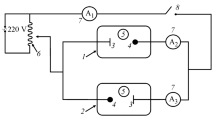Conclusions
The process of galvanodynamically producing copper powder can be intensified by employing the procedure of bubbling air through the near-anode space to achieve an increase in the limit current density for a laminar electrolyte flow regime about the cathode surface.
The use of this bubbling procedure makes it possible to produce a powder with an elevated bulk density whose magnitude is determined by the ratio of the discharge current density for the metals at the tips of the dendrites relative to the limit diffusion current density. With an increase in this parameter the bulk density of the powder is reduced.
Industrial tests of the galvanodynamic method for production of copper powder involving the use of the air-bubbling method show the possibility of producing a powder with a uniform copper composition and a bulk density in the electrolysis stage on the order of 2 g/cm 3.
Similar content being viewed by others

Literature cited
O. A. Potapov, N. V. Andreev, I. B. Murashova, et al., “The technological characteristics of a copper powder and the dendrite structures as they relate to the conditions of electrolysis under constant overvoltage,”Porosh. Metall., No. 2, 1–4 (1990).
I. B. Murashova, S. L. Korkin, A. V. Pomosov, and D. G. Susloparov, “A method for the production of a copper powder by electrolysis,” USSR Author's Certificate 243,907;Otkryt. Izobret., No. 26, 57 (1986).
S. L. Korkin, I. B. Murashova, A. V. Pomosov, et al., “The effect of a galvanodynamic electrolysis regime on the properties of a copper powder and strength of pressed items fabricated from that powder,”Porosh. Metall., No. 11, 4–7 (1986).
I. B. Murashova, S. L. Korkin, A. V. Pomosov, et al., “Electrodeposition of dispersed copper under conditions of a linearly increasing current,”Porosh. Metall., No. 10, 8–14 (1986).
T. N. Tishkina, I. B. Murashova, A. V. Pomosov, et al., “The dynamics of copper dendrite growth as a function of temperature,” Paper No. 841XII-D83 Deposited at ONIITÉKhIM, Sverdlovsk (1983).
A. A. Chernov, T. F. Voronina, and A. P. Pavlinov, “Intensification of electrochemical processes by pulsed intermixing of the electrolyte,”Khim. Prom-st, No. 3, 182–184 (1983).
A. M. Yampol'skii and V. A. Il'in,A Brief Handbook of Galvanic Engineering [in Russian], Mashinostroenie, Leningrad (1981).
I. B. Murashova and E. E. Usol'tseva, “Depth of process penetration on a friable electrode with electrodeposition of a dispersed metal,”Elektrokhimiya,24, No. 7, 885–891 (1988).
I. B. Murashova, A. V. Pomosov, S. L. Korkin, et al., “A method for the production of copper powder by electrolysis,” USSR Author's Certificate 1,346,697;Otkryt. Izobret., No. 39, 130 (1987).
Author information
Authors and Affiliations
Additional information
Translated from Poroshkovaya Metallurgiya, No. 12(348), pp. 77–81, December, 1991.
Rights and permissions
About this article
Cite this article
Murashova, I.B., Agafodorova, I.N. & Korkin, S.L. Electrodeposition of a copper powder with elevated bulk density and fluidity out of a surging electrolyte. Powder Metall Met Ceram 30, 1057–1060 (1991). https://doi.org/10.1007/BF00794440
Received:
Issue Date:
DOI: https://doi.org/10.1007/BF00794440


